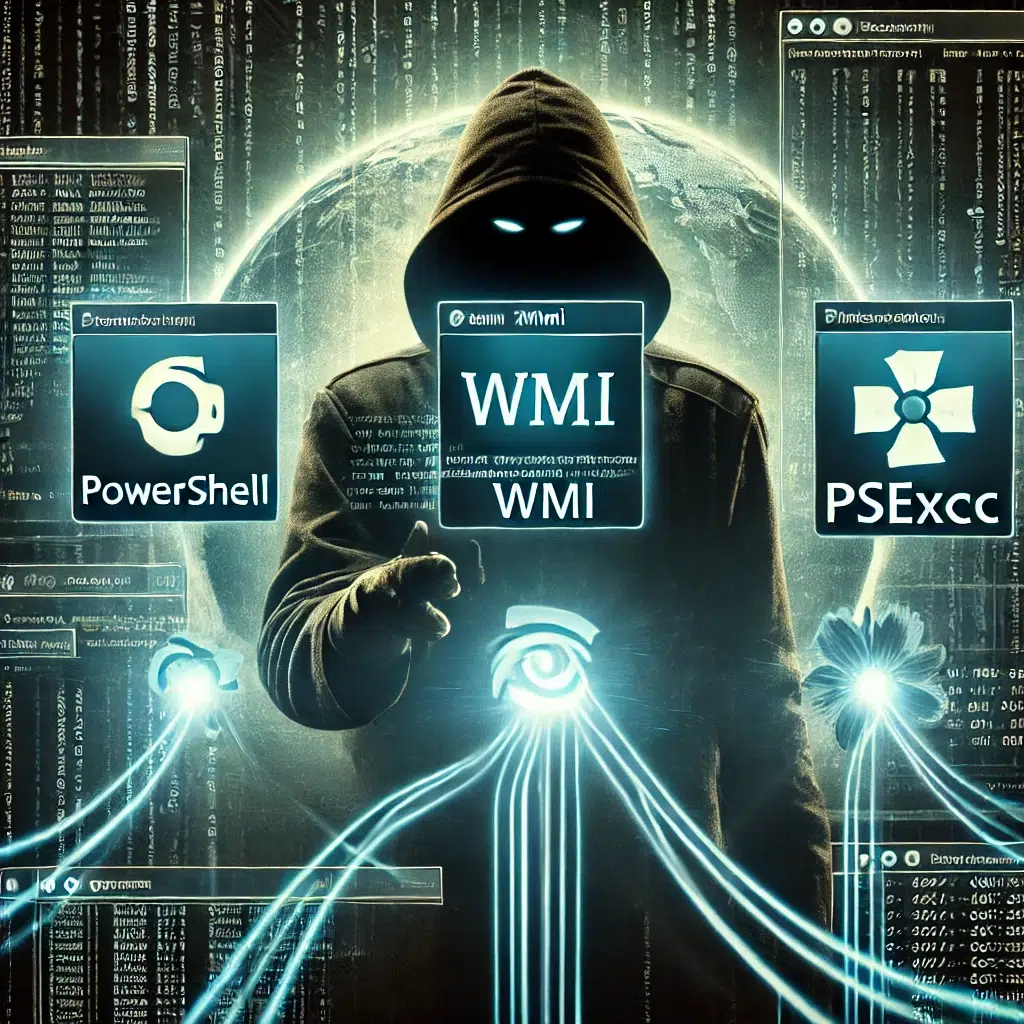With the third article in our series on Living Off the Land (LOTL) attacks, we dive deeper into defense strategies that organizations can implement to safeguard their infrastructure from these highly elusive threats. LOTL attacks, where attackers exploit legitimate tools within the network to execute malicious activities, pose unique challenges for detection and response. Because these attacks rely on trusted utilities like PowerShell, WMI, and PsExec, they can blend seamlessly into an organization’s normal operations, bypassing traditional security measures. As a result, defending against LOTL requires a combination of advanced detection techniques and tailored defense strategies designed to fit the specific needs of each organization.
Why LOTL Attacks Are So Difficult to Defend Against
LOTL attacks exploit the very tools and systems that IT professionals rely on for legitimate operations, making detection exceptionally difficult. Attackers leverage trusted tools, gaining access and moving laterally across the network without triggering traditional alarms. This makes signature-based detection methods, such as antivirus software, ineffective because they are looking for malicious code or unrecognized files. Instead, defenders must monitor for abnormal usage patterns of legitimate software, focusing on behavior rather than signatures.
Key challenges of LOTL attacks
Living Off the Land (LOTL) attacks present a unique set of challenges that make them particularly difficult to detect and defend against. One of the primary challenges is the exploitation of trusted tools. Attackers rely on utilities like PowerShell, WMI, and PsExec—tools that are essential for legitimate administrative tasks within an organization’s IT environment. By using these familiar tools, attackers can carry out malicious activities without raising immediate suspicion, as these utilities are part of normal operations.
Another significant challenge posed by LOTL attacks is their ability to evade traditional security measures. Since these attacks do not involve the introduction of new or foreign malware into the system, signature-based defenses like antivirus programs or intrusion detection systems often fail to identify them. These tools are typically designed to flag unfamiliar files or behaviors, but in LOTL attacks, attackers work within the confines of authorized processes, rendering conventional detection tools ineffective.
Finally, lateral movement within networks adds another layer of complexity to defending against LOTL attacks. Once attackers have gained initial access, they can use legitimate credentials to move from one system to another, making it difficult for security teams to differentiate between normal user behavior and malicious activity. This ability to move laterally across the network allows attackers to escalate their privileges, gain broader access to sensitive systems, and persist within the environment for extended periods without detection. The combination of these factors makes LOTL attacks both sophisticated and dangerous, requiring advanced detection and response strategies to effectively combat them.
Comprehensive Monitoring and Behavioral Detection
One of the most effective ways to defend against LOTL attacks is by leveraging comprehensive monitoring tools that focus on behavior rather than static indicators of compromise. Solutions like Endpoint Detection and Response (EDR) play a crucial role here. These tools continuously monitor endpoints for unusual activity, flagging deviations from normal behavior that may signal an ongoing attack. Unlike traditional antivirus solutions, which rely on known threat signatures, EDR tools use behavioral analytics to detect patterns of misuse, such as abnormal PowerShell executions or unusual administrative access attempts.
While EDR tools are effective, they must be complemented by application whitelisting, where organizations restrict the execution of non-essential scripts and applications. By enforcing strict controls over which programs can run, organizations can limit the tools available for attackers to exploit, significantly reducing the attack surface for LOTL-based exploits. This is particularly useful for preventing attackers from executing unauthorized scripts or accessing critical systems with administrative privileges.
Privileged Access Management (PAM) and Lateral Movement Detection
Privileged Access Management (PAM) systems are essential for limiting unauthorized access to sensitive tools that can be exploited in LOTL attacks. PAM enforces the principle of least privilege, ensuring that only authorized users have access to critical systems and utilities like PsExec or PowerShell. PAM solutions also maintain detailed audit logs, enabling security teams to track any misuse of administrative privileges, providing critical forensic data in the event of an attack.
In large, distributed networks, attackers often seek to move laterally across systems once they gain initial access. Monitoring internal, or “east-west,” network traffic is crucial for detecting these movements. Solutions like Network Detection and Response (NDR) can track unusual lateral movement patterns, such as unexpected communication between systems that don’t typically interact. By segmenting the network and monitoring internal traffic, organizations can limit the extent of lateral movement and contain threats before they spread further.
Tailoring Defense Strategies to Your Organization’s Needs
Defending against LOTL attacks requires a tailored approach that reflects the size, complexity, and industry of each organization. Small and medium-sized businesses (SMBs) face different challenges than large enterprises, and industry-specific regulations—such as HIPAA in healthcare or PCI DSS in finance—further complicate the defense landscape. Adapting defense strategies to these unique needs is essential for success.
Small and Medium-Sized Businesses
SMBs often operate with limited IT resources and smaller security budgets, making them attractive targets for LOTL attacks. However, SMBs can still defend themselves effectively by focusing on key strategies such as:
Endpoint Detection and Response (EDR): Automated EDR solutions can provide real-time detection and response without requiring large, dedicated security teams.
Application whitelisting: Restricting the execution of unnecessary scripts reduces the attack surface and limits what attackers can exploit.
Cloud-based security tools: Leveraging cloud-native security solutions can provide centralized control and monitoring, helping to detect LOTL activity in cloud environments.
Large Enterprises
For large organizations with complex IT environments, the challenges become even greater due to the vast number of endpoints and the potential for lateral movement across the network. Effective defense strategies include:
Security Information and Event Management (SIEM): SIEM systems aggregate data across the entire organization, using machine learning to detect anomalous activity that may signal LOTL attacks.
Privileged Access Management (PAM): Limiting access to critical tools and auditing privileged accounts helps to prevent unauthorized exploitation of administrative utilities.
Network segmentation and lateral movement detection: By segmenting the network and closely monitoring internal traffic, organizations can detect and contain attackers before they move freely across the network.
Industry-Specific Considerations
Certain industries face additional challenges when it comes to LOTL attacks, and tailoring defenses to these sectors is critical. For example, in the financial sector, where attackers often target high-value transactional systems, continuous monitoring for anomalies in financial data and transactions is essential. Financial institutions must also integrate sector-specific threat intelligence into their security systems to stay ahead of attackers targeting the industry.
In healthcare, the reliance on legacy systems and interconnected medical devices introduces unique vulnerabilities. These devices, often difficult to patch or update, require compensating controls such as enhanced monitoring, network segmentation, and strict access controls to prevent unauthorized access and exploitation in LOTL attacks.
Proactive Threat Hunting and Continuous Monitoring
A proactive defense approach is critical in identifying and mitigating LOTL attacks before they cause significant harm. Threat hunting, where security teams actively search for signs of compromise within the network, is a key strategy for detecting subtle attack patterns that might evade automated detection tools. Regular threat-hunting exercises, combined with advanced analytics, enable organizations to stay ahead of attackers, continuously refining their defenses based on emerging threats and attack trends.
While tools like EDR, SIEM, and PAM are indispensable, they are most effective when used in conjunction with continuous monitoring and proactive threat detection. LOTL attacks thrive in environments where security teams only respond to alerts. By taking the initiative and actively searching for potential threats, organizations can detect LOTL activity early, before attackers can escalate their operations.
Conclusion
Living Off the Land attacks are among the most sophisticated and difficult threats to defend against, but with the right combination of behavioral monitoring, privilege management, network segmentation, and proactive threat hunting, organizations can significantly reduce their risk. Whether defending a small business or a large enterprise, tailoring these strategies to fit the specific operational and regulatory needs of the organization is crucial. By implementing these advanced defense mechanisms and continuously refining their security posture, organizations can stay one step ahead of attackers who exploit legitimate tools for malicious purposes.





